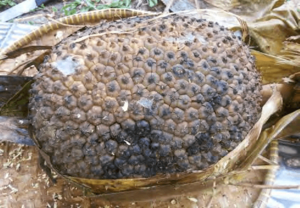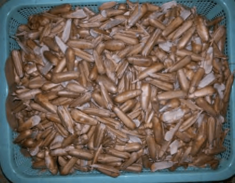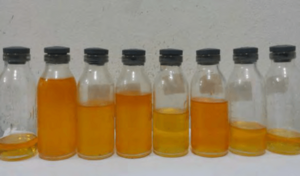Karuka facts for kids
Quick facts for kids Karuka |
|
|---|---|
 |
|
| Pandanus julianettii fruit cluster | |
| Scientific classification | |
| Genus: |
Pandanus
|
| Species: |
julianettii
|
| Synonyms | |
|
|
 |
|
| Nutritional value per 100 g | |
|---|---|
| Energy | 2,259–2,929 kJ (540–700 kcal) |
|
28-33.5 g
|
|
| Sugars | 5 g |
| Dietary fiber | 9.2-25 g |
|
35.6-47 g
|
|
| Saturated | 18 g |
| Trans | 0 |
|
Protein
|
11.9-18 g
|
| Tryptophan | 102-136 mg |
| Threonine | 435-482 mg |
| Isoleucine | 503-555 mg |
| Leucine | 904-993 mg |
| Lysine | 426-526 mg |
| Methionine | 272-279 mg |
| Cystine | 204-234 mg |
| Phenylalanine | 571-613 mg |
| Tyrosine | 408-438 mg |
| Valine | 745-832 mg |
| Arginine | 1238-1329 mg |
| Histidine | 293-336 mg |
| Alanine | 585-642 mg |
| Aspartic acid | 1064-1197 mg |
| Glutamic acid | 2285-2453 mg |
| Glycine | 638-701 mg |
| Proline | 530-613 mg |
| Serine | 545-584 mg |
| Vitamins | Quantity
%DV†
|
| Vitamin A | 2 IU |
| Vitamin C |
8%
6.40 mg |
| Vitamin E |
3%
0.46 mg |
| Minerals | Quantity
%DV†
|
| Calcium |
51%
97-460 mg |
| Iron |
3223%
419 mg |
| Phosphorus |
169%
220-360 mg |
| Potassium |
10%
300.22 mg |
| Sodium |
5%
71.21 mg |
| Other constituents | Quantity |
| Water | 9% |
| Cholesterol | 0 |
| †Percentages estimated using US recommendations for adults. | |
| Nutritional value per 100 g | |
|---|---|
| Dietary fiber | 5.3 g |
|
0.43 g
|
|
|
Protein
|
8.5 g
|
| Threonine | 289 mg |
| Isoleucine | 281 mg |
| Leucine | 485 mg |
| Lysine | 196 mg |
| Methionine | 170 mg |
| Phenylalanine | 315 mg |
| Tyrosine | 323 mg |
| Valine | 340 mg |
| Arginine | 255 mg |
| Histidine | 162 mg |
| Alanine | 391 mg |
| Aspartic acid | 672 mg |
| Glutamic acid | 748 mg |
| Glycine | 459 mg |
| Proline | 196 mg |
| Serine | 315 mg |
| Minerals | Quantity
%DV†
|
| Calcium |
12%
120 mg |
| Phosphorus |
20%
140 mg |
| Other constituents | Quantity |
| Cholesterol | 0 |
| †Percentages estimated using US recommendations for adults. | |
The karuka (Pandanus julianettii) is a type of tree that grows in New Guinea. It is also known as the karuka nut or Pandanus nut. This tree is very important because its nuts are a major food source for people in the region.
Karuka nuts are even more nutritious than coconuts. They are so popular that families in the New Guinea Highlands often move their homes closer to the karuka trees during harvest season.
Contents
What's in a Name?
The scientific name "julianettii" was chosen to honor Amedeo Giulianetti. He was a naturalist who first found samples of this tree.
Local Names for Karuka
The word 'Karuka' comes from the Tok Pisin language. Sometimes people call the tree 'karuga' or 'karuka nut pandanus'. The name 'karuka' can refer to Pandanus julianettii and also to P. brosimos. However, P. brosimos is usually called 'wild karuka'.
Both P. julianettii and P. brosimos, along with P. dubius, can be called 'pandanus nut'. Other types of 'wild karuka' include P. antaresensis, P. iwen, and P. limbatus. But their nuts are not as big a part of the local diet.
When people talk about different karuka types, P. julianettii is sometimes called 'planted karuka'.
In New Guinea, different groups of Papuan people have their own names for the karuka tree. For example:
- In the Ankave language, it's xweebo.
- In the Baruya language, it's yase.
- The Huli language and Duna language word is anga.
- In Kewa language, it's aga.
- The Kalam language calls it alŋaw, or sometimes kumi or snay.
- In the Wiru language, it's ama.
- The Pole language calls it maisene.
- In Angal language, it's ank, and in the Wola dialect, aenk.
- The Imbongu language word is amo.
On the other side of the island, in Indonesia, it's called pandan kelapa (meaning "coconut pandan") or kelapa hutan (meaning "forest coconut"). The Dani people call it tuke.
What Does the Karuka Tree Look Like?
The karuka tree can grow very tall, from 10 to 30 meters (about 33 to 98 feet) high. Its trunk is grey and about 30 centimeters (12 inches) wide. The trunk has white spots and rings from old leaves. Big roots at the bottom help support the tree.
Leaves and Flowers
The leaves grow in a spiral pattern up the trunk. They are large and leathery, about 3 to 4 meters (10 to 13 feet) long. The edges and middle of the leaves have small prickles. The top of the leaves is dark green, and the bottom is a dull blue-green.
Karuka trees are usually either male or female. Male trees have long, white flower spikes that can be up to 2 meters (6.5 feet) long. Female trees produce a single large fruit cluster. Female trees can make fruit even without pollination, which is why they are often grown by people.
The Fruit Cluster
The fruit cluster is round or oval and can be 15 to 30 centimeters (6 to 12 inches) wide. It can weigh up to 16 kilograms (35 pounds), but usually averages 6 kilograms (13 pounds). Each cluster has about 1000 nuts packed tightly together.
The nuts themselves are usually about 9 centimeters (3.5 inches) long and pale blue-green. Inside the fruit cluster, after the nuts are removed, there is a spongy, pink core that looks like honeycomb.
The karuka tree is similar to P. utilissimus, which is found in the Philippines. People also eat nuts from other related Pandanus species like P. antaresensis, P. brosimos, P. dubius, P. iwen, and P. limbatus.
Different Types of Karuka
There are many different types, or cultivars, of karuka. There might be as many as 45 known types, each with slightly different nut shapes. Some types are only known by a few people in small villages.
'Tabuna' and 'Henga' are two of the most important types. 'Tabuna' is popular because it produces a lot of nuts, tastes good, and can be eaten by anyone without special rules. At least two types of karuka can be eaten raw.
Here are some of the named varieties:
- Baerel
- Bort
- Dob
- Dobiyael
- Dor
- Emonk
- Gaslŋ
- Goalia
- Gurubu
- Hagidara
- Hael
- Hap
- Henga
- Homagal-iba
- Honal
- Honde
- Hones
- Humbuwm
- Kaba
- Kabali
- Kagat
- Kai
- Kambiyp
- Kat
- Kebali
- Kongop
- Korhombom
- Laek
- Lebaga
- Mabiyp
- Mabu
- Maeka
- Maela
- Maeraeng
- Mbul
- Morguwm
- Nenjay
- Ngaule
- Nolorwaembuw
- Ohaib
- Ombohonday
- Padua
- Pari
- Pebet
- Peliya
- Piliyhongor
- Posjuwk
- Sayzel
- Shond
- Shuwimb
- Tabuna
- Tabuwn
- Taeshaen
- Taziy
- Tenyon
- Tiyt
- Toi
- Tolo
- Tombpayliya
- Tomok
- Tumbi
- Tumbu
- Womb
It's possible some of these names refer to the same type, as New Guinea has many different languages.
Where Does Karuka Grow?
The karuka tree grows naturally and is also farmed in New Guinea. This includes both Papua New Guinea and the Papua province in Indonesia. Wild karuka trees are found in the Huon Peninsula and the central mountains of New Guinea.
In Papua New Guinea, it is most commonly grown in the Southern Highlands, Western Highlands, Eastern Highlands, Enga, and Chimbu provinces. It grows in mountain forests between 1,300 and 3,300 meters (about 4,265 to 10,827 feet) high. These areas get a lot of rain, between 2 and 5 meters (6.5 to 16 feet) each year. Karuka trees prefer good soil but can grow in both dry and wet ground. They often grow in groups of 5 to 10 trees per hectare.
Karuka Tree Life Cycle and Ecology
Karuka trees usually produce fruit around February. Sometimes there's a smaller harvest season in July. Each branch typically flowers every other year. We don't know exactly how they are pollinated in nature, but humans can help pollinate the flowers.
Animals like birds and rats help spread the karuka seeds. The Lorentz's mosaic-tailed rat is known to help spread seeds for the Kalam people in Madang Province. A fallen fruit cluster will break apart in the forest in about three days.
Pests and Problems
Like many plants, karuka trees can be affected by pests.
- Fungi: Some fungi cause leaf spots or molds, but they usually don't do much harm.
- Bacteria: A type of bacteria can cause soft rot and damage to the leaves.
- Insects: Longhorn grasshoppers are a big problem. They eat the leaves and can sometimes kill the trees. Farmers sometimes stuff leaves and grass into the tree's crown to keep insects out. Black grubs can burrow into the fruit cluster and eat the core, making the nuts turn black and fall off.
- Animals: Possums and different types of rats love to eat karuka nuts. Farmers sometimes put platforms or other barriers on the tree trunks to stop these animals.
After harvest, rats and cockroaches can also bother the stored nuts. Hanging the nuts in smoky areas above fires can help prevent this, but it can change the taste of the nuts over time.
How Humans Use Karuka
Karuka has been a very important food source in New Guinea for a long time, even for nearly 31,000 years! In Papua New Guinea, almost half of the people in rural areas eat karuka regularly. It's in high demand in the New Guinea Highlands. During harvest time, entire families, including their pigs, will move to higher areas where the trees grow. They often stay there for several weeks. Each family might own between 12 and 176 karuka trees.
Food and Nutrition
The white kernel inside the nut is the part that is eaten. It can be eaten raw, roasted, smoked, or cooked in an earth oven. Nuts that aren't eaten right away are often sun-dried for storage. Karuka kernels can taste sweet like coconut or savory like walnuts.
Smoked or cooked karuka is either stored in the house rafters or sold at local markets. Uncooked fruit clusters can also be stored for months by burying them in wet ground, which might cause them to ferment. Karuka is a main food in the region and is one of the few plants there with a high protein content. The spongy core of the fruit cluster can also be cooked and eaten after the nuts are removed.
Karuka nuts have a lot of fat, so they can be made into an edible yellow oil. This oil is a good source of Vitamin E. The yellow color comes from carotenoids.
Other Uses for the Tree
The trunks and large roots of the karuka tree are used for building houses. The bark sheets are used for house walls. The leaves are used to make shelters and raincapes. Before colonial times, karuka leaves were the most popular building material for homes in Papua New Guinea. The strong white leaves from male flowers are used by the Wola people to wrap pearl shells.
Growing Karuka Trees
Karuka trees can be grown by cutting a mature branch and planting it. Young shoots that grow from the base of the tree can also be replanted. Some nurseries also plant seeds directly. New nuts will start to grow when a tree is at least five or six years old. A single tree can keep producing nuts for up to fifty years!
The tree can handle cold temperatures, even down to 3°C (37°F) for long periods and 0°C (32°F) for short times.
In some areas, like Upper Karint near Pingirip, karuka trees are planted to mark the boundaries between garden plots.
Karuka in Culture
In Papua New Guinea's Central Province Premier Rugby League, the team from Goilala District is called the Karukas.
Images for kids





